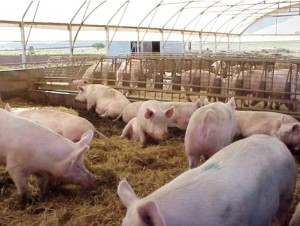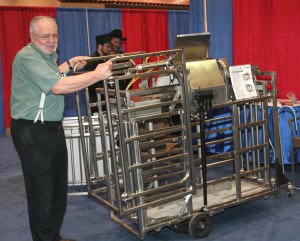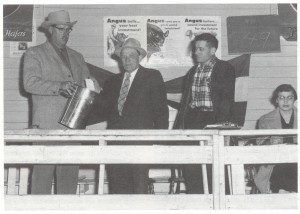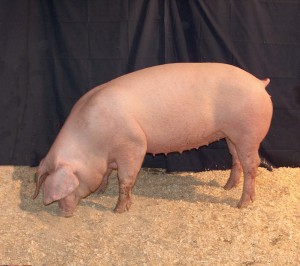CQA Program reaches 10-year milestone
Posted in: Uncategorized by admin on July 14, 2011 | No Comments
On April 8, 1998, a small group of Canadian hog industry stakeholders and government representatives gathered in Ottawa to announce the launch of the Canadian Quality Assurance Program, an on-farm food safety program for Canadian hog producers. Shortly after that announcement, the first farms were enrolled.
The development of the program had begun in the fall of 1995, and over the next two and a half years, producers, veterinarians, processors and production specialists from across the country worked together to come to a consensus on a Canadian program that would be based upon science, rather than the whims of the marketplace.
While 2007 participation numbers have yet to be completed, registration data at the end of 2006 reflected a little over 7000 production sites representing 68% of all hogs born in Canada and 95% of all hogs processed in Canada.
The launch of the program represented a reinforcement of the idea that Canadian hog farmers are producing not only an animal, but a food product, and that these producers are committed to taking all the necessary steps on farm to produce a safe product. The CQA program offered an opportunity for producers to have a third-party assessment of their production practices, following a common standard across the country, a practice that was being adopted throughout European countries and that was being requested by major pork importing countries.
Despite a rocky start to the program, with hog prices crashing during the fall of 1998, producers recognized the importance of CQA and that this was the direction that the worldwide hog industry was taking. Canadian pork had an excellent reputation as a high-quality and safe product and the CQA program would support that and offer evidence to a world that no longer worked on a handshake.
While CQA had been piloted on a number of farms across the country, the early days, as with the beginning of any program, reflected areas that needed improvement to make the program as user-friendly as possible and as flexible as possible to meet the needs of the various producers and production types across the country while still maintaining program integrity on the world stage. These changes were made and built upon over the years to strengthen the program and support the producers who took part in it.
From early in the development of the program, there was interest in having the support of the federal government in recognizing on-farm food safety programs. The Canadian Food Inspection Agency worked together with commodity groups to develop a recognition program. This recognition program was implemented only after the CQA program had been in operation for some time, but was used as a tool to review the program content for updating and submission to CFIA for technical review. In 2004, the Canadian Pork Council and CFIA announced that the CQA program had successfully completed technical review and program materials were re-launched with an updated look, a new layout and a website.
CQA program materials continue to be regularly reviewed and updated. This program is very much a living one that is constantly striving to meet the needs of producers and the marketplace, to respond to updates in scientific understanding and government regulations. During this most recent downturn in the Canadian hog industry, the CQA program continues to be a part of the day-to-day operations of farms across the country and an important tool in managing hog farms as well as demonstrating Canadian producer commitment to providing a safe and high quality product to Canadians and to the world.
For more information on the CQA program, you can visit the website at www.cqa-aqc.com or contact your provincial delivery agent.
Pigs Down Under
Posted in: Economics, Environment, Production, Uncategorized, Welfare by admin on | No Comments
High feed prices and low hog prices have led to a huge increase in sow slaughterings in Australia and there is a low level of confidence among producers, says production consultant John Riley. Meanwhile, imports of pork products soar, including those from Canada, putting even more pressure on producers.
The winter edition of the Western Hog Farmer summarizes the Canadian industry’s response to high feed costs, the weakness of the US dollar and unsatisfactory market returns.
The dismal picture in Canada is mirrored in the Australian industry. In the last month, one of the largest production units in Queensland that is owned by a Japanese company has been put on the market. If this 7,000 sow, farrow to finish business closes, there will be serious repercussions for the local feed mill and the two abattoirs in the state.
Another company to call it a day is the breeding company Hyfarm-JSR. They have sold their 600-sow high health nucleus unit to a Dutch family who recently settled in the state. In addition, the Hyfarm-JSR multiplication unit is now on the market with limited expressions of interest by prospective purchasers.
Ironically, the Dutch family were encouraged to settle in Australia by a state government in 2002 which promoted the financial benefits of investing in the pig industry in Queensland.
 The Productivity Commission report that handed down its findings in December, determined that the unprofitability of the Australian industry was not due to imports from the USA, Denmark and Canada, but was due to high feed costs.
The Productivity Commission report that handed down its findings in December, determined that the unprofitability of the Australian industry was not due to imports from the USA, Denmark and Canada, but was due to high feed costs.
In parts of New South Wales and Queensland, harvesting of the sorghum crop is well advanced with record yields being recorded. Sorghum is a summer grain crop used in animal feeds. Normally the price is around $AU160 per tonne but this year the price is holding firm at around $AU$260 per tonne due to the high demand worldwide for wheat and barley. The usual seasonal reduction in average feed costs has not materialized so far in 2008.
During the last quarter of 2007, sow slaughtering was 49.5% higher than in the last quarter of 2006. The level of imports of processed pig meat during the 12 months ending December 2007 was 29% higher than in 2006 with imports from Canada totalling 43,415 tonnes shipped weight, an increase of 24.8% on the previous year. In the same period imports from the United States increased by 52%.
The lack of confidence in the industry has resulted in very little investment in housing systems that comply with the new welfare codes. The codes dictate that within ten years, housing of sows in stalls for more than four weeks during gestation will not be allowed.
A few producers in the east that have moved to group housing in gestation have adapted grower pens and introduced feeding of small groups.
In some instances in Western Australia sows have been housed in larger groups on deep litter in shelters and fed through traditional feeding stalls on a concrete pad in or adjacent to the shelter. The feeding stalls service more than one group of pigs on a rotation system. The main disadvantage of the system is the high labour required in moving sows.
There is only limited interest in electronic feeding systems. In the past Australia’s isolation in regard to after sales services has led to frustration and a few systems that were installed in the early 1990’s were subsequently removed. However, interest has been rekindled in recent months and two large-scale producers have installed Mannebeck systems in naturally ventilated slatted floor sheds.
In addition to high feed costs and poor market returns, producers in Queensland were shocked to read in March of their state government’s proposal to increase the cost of meeting the environmental legislation. The proposal, if implemented, will see a producer with 100 sows producing bacon pigs paying $52 per sow per year to government and a producer with 600 sows with progeny to bacon will pay about $9,800 per annum. The State government has decided on a policy of full cost recovery from potential polluters of the environment for the implementation and the policing of the legislation. Interestingly a local mining company selling gold worth $108 million will pay just $20,000 if the legislation is passed.
A further major change will dictate that multi-site operations will pay the fee on every site because multi site discounts will be withdrawn. Pig producers in Queensland are far from happy and more could well exit the industry in the next six months.
Photo caption:
Group sows-1 – Producers in Australia are moving towards group sow housing
News and Views – Dr. Walter Heuser joins Pfizer Animal Health
Posted in: Uncategorized by admin on | No Comments
 Pfizer Animal Health Canada has announced that Dr. Walter Heuser, BSP DVM has joined the company’s swine team.
Pfizer Animal Health Canada has announced that Dr. Walter Heuser, BSP DVM has joined the company’s swine team.
“We are thrilled to have a veterinarian with Walter’s reputation and experience join our marketing team,” said Peter Mumford, Swine Business Unit Director, Pfizer Animal Health Canada. “With nearly 30 years of experience as a practicing veterinarian, Walter has a keen understanding of the needs and practices of both veterinarians and producers.”
Dr. Heuser has been working with Pfizer Animal Health as a technical support veterinarian on a part-time basis since April 2007. In his new, full-time role with the company he will be part of the marketing team and will lead the launch of a new swine product expected to be available in 2009.
Dr. Heuser was most recently owner and an active partner at Sheridan, Heuser, Provis Swine Health Services in Steinbach, MB. Established in 1988, the practice employs eight veterinarians and provides health and production support to independent swine producers, breeding stock producers and integrated swine companies.
He is also a member of the advisory board for the Vaccine and Infectious Disease Organization (VIDO), the board of the Canadian Integrated Program for Antibiotic Resistance Surveillance (CIPARS) and the International Pig Veterinary Society (IPVS) 2010 organizing committee.
Portable sorter designed for small group systems
Posted in: Environment, Production, Uncategorized by admin on | No Comments
 Automatic sorting systems for finishing pigs are becoming more and more common. However, they are only justified economically where group size is 500 or more. In order to gain the same benefits where pigs are housed in smaller groups, Crystal Spring Hog Equipment, based in St. Agathe, Man., have developed the “egate” portable electronic sorter. Constructed in stainless steel, its unique feature is that the rear end of the weighing crate folds up, reducing the length of the scale, which allows it to be moved around in conventional barn layouts with a central alleyway. Jonathan Kleinsasser, Managing Director of Crystal Spring, says that the scale marks pigs automatically if they are ready for market and also marks pigs that will be ready the following week. It displays the average weight of these two groups of pigs and the average weight of all the pigs weighed, so that growth rate can be calculated. The crate has an automatic sorting gate, which allows selection and removal of market weight hogs, while the others can be returned to the pen.
Automatic sorting systems for finishing pigs are becoming more and more common. However, they are only justified economically where group size is 500 or more. In order to gain the same benefits where pigs are housed in smaller groups, Crystal Spring Hog Equipment, based in St. Agathe, Man., have developed the “egate” portable electronic sorter. Constructed in stainless steel, its unique feature is that the rear end of the weighing crate folds up, reducing the length of the scale, which allows it to be moved around in conventional barn layouts with a central alleyway. Jonathan Kleinsasser, Managing Director of Crystal Spring, says that the scale marks pigs automatically if they are ready for market and also marks pigs that will be ready the following week. It displays the average weight of these two groups of pigs and the average weight of all the pigs weighed, so that growth rate can be calculated. The crate has an automatic sorting gate, which allows selection and removal of market weight hogs, while the others can be returned to the pen.
For further information, contact Jonathan Kleinsasser on (204) 433-7178, email info@crystalspringhog.com or visit www.crystalspringhog.com
Photo:
Portable sorter – The egate portable sorter has a fold-up rear section making it easier to move around
Manitoba Swine Seminar – PRRS continues to be major health challenge, says Minnesota vet.
Posted in: Production, Uncategorized, Welfare by admin on | No Comments
Despite good success in controlling and reducing PRRS in North America, the virus continues to be a leading cause of illness among sows, says Dr. Tim Loula. “PRRS has been the major health challenge in the industry since the 1980s,” said Loula, a veterinarian working out in the Swine Vet Center in St. Peter, Minnesota.
Loula was in Winnipeg on January 30 to address producers attending Manitoba Swine Seminar 2008. This past winter, he reported, a large percentage of the American
Midwest was infected with PRRS and there was an outbreak in China in January. He noted that outbreaks are worse in winter. Among the effects of the disease, Loula listed lower litter size, lower farrowing rate, lower average daily gain, increased feed conversion, increased cost of medications and vaccinations, increased variation, decreased number of full value market hogs and higher mortality rates.
Loula described the creation of a North American PRRS Eradication Task Force that was initiated at the AASV board of directors meeting in Kansas City in 2006. The Task Force’s goal is the complete eradication of PRRS. Members, Loula said, have been starting local task forces in their regions bringing together producers, production systems, vets, industry partners and researchers to eliminate the disease region by region. He reported that such task forces have already been established in Ontario, North Carolina and Minnesota. Three counties in Minnesota have eradicated PRRS in their area.
“The first step is to map out where the pigs and the viruses are so that we can track where they are going,” Loula said. He discussed some current methods of eliminating the disease in specific herds. One way is to depopulate and then repopulate the site. By moving the entire herd out of the barn, the producer is able to clean and disinfect the entire site. The herd is brought back in after everything has dried and the process takes about a week. Follow-up studies, Loula reported, show that 49% of farms are still clear after 120 weeks and 39% after 150 weeks.
Herd closure is another method of controlling or eliminating PRRS by stopping the introduction of replacement animals to the sow herd for an extended period of time. Those farms that have kept out replacement sows for more than 200 days have generally been successful. This method allows the herd to develop a strong immunity to the virus. New sows can be brought in 30 days after the last clinical signs of the disease.
Producers can also try a direct virus exposure using serum. Of more than 150,000 sows thus treated, Loula said, there were only two bad experiences. A test and removal approach, Loula noted, is not in common use and works best alongside a second type of stabilization program.
Loula spoke of biosecurity measures intended to keep PRRS at bay in the first place. He suggested filters to keep insects out of the barns and having visitors remove their shoes.
He also noted that vaccines are also available for some strains. “Hog producers need to become knowledgeable about epidemiology, sanitation and biosecurity,” Loula said. “That will benefit you long after the herd is free of the disease.”
Lacombe breed celebrates 50 years
Posted in: Uncategorized by admin on | No Comments
The Lacombe hog, the only “made in Canada” pig, celebrates 50 years since its creation, although there are now not many of them around to crack open the champagne! Developed at the Lacombe Research Station, work on the new breed started in 1947 and was completed in 1958. The brainchild of Station Superintendent (later Director) Jack Stothart and geneticist Howard Fredeen, the Lacombe was bred from Danish Landrace, Berkshires from Britain and Chester Whites from the USA. “The intention was to produce a sire line that could be crossed with a Yorkshire sow to produce vigorous, fast-growing progeny with a good carcass,” explains Jurgen Preugschas of Five Lakes Farms, near Mayerthorpe, Alta., who, with his brother Walter, has 200 purebred Lacombes. “In those days, a pure Danish Landrace was used to cross with the Yorkshire, but they were not robust enough,” adds Alfred Wahl, General Manager of Peak Swine Genetics, which utilizes the Lacombe in its Trailblazer boar. “They needed a bacon pig, but without any colour, because bacon had the rind on in those days. Hardiness was also a key objective and that came from the Chester White breed.”
The three component breeds were crossed and back-crossed to form a pure composite breed, with selection being based on growth rate, litter size and carcass quality of 3-4 randomly selected littermates. Any pigs that had below average performance or had coloured skin were culled and these criteria led to 76% of all potential breeding stock being discarded. The resulting purebred Lacombe hog had 55% Landrace, 22% Chester White and 23% Berkshire genes.
 Based on the results obtained in field testing of the Lacombe when used for crossbreeding and also in purebred experimental herds at Scott, Indian Head, Olds and Vermilion, the advisory committee recommended release of the breed in 1957. Contract multiplier herds were then established, complete pedigree records were submitted to Canadian National Livestock Records and genetic purity for white colour was established. Also, Jack Stothart and Howard Fredeen developed a system of selective registration, based on minimum standards for growth rate, feed efficiency, and carcass merit. The Lacombe was the only breed to have this requirement, which provided proof of the pigs’ performance potential.
Based on the results obtained in field testing of the Lacombe when used for crossbreeding and also in purebred experimental herds at Scott, Indian Head, Olds and Vermilion, the advisory committee recommended release of the breed in 1957. Contract multiplier herds were then established, complete pedigree records were submitted to Canadian National Livestock Records and genetic purity for white colour was established. Also, Jack Stothart and Howard Fredeen developed a system of selective registration, based on minimum standards for growth rate, feed efficiency, and carcass merit. The Lacombe was the only breed to have this requirement, which provided proof of the pigs’ performance potential.
The first public exhibition of the Lacombe was made at the National Swine Show held in Brandon on July 1, 1957. This was followed on October 7th by a public draw to determine the recipients of the first 50 boars released. There were 823 applications and the successful producers came from right across Canada. Among these was Jurgen Preugschas’ father, Kurt, who had not previously been involved in producing purebred pigs. “You had to send in a submission explaining why you wanted to be a Lacombe breeder,” explains Jurgen Preugschas. “My father had been involved in breeding pigs, cattle and horses in Germany and his success in the draw gave him a start in swine breeding here in Canada.”
From 1958 onwards, breeding groups of Lacombes were released each year and, by 1960, 462 breeding females were in the hands of private breeders. “This new pig really only became available to breeders in 1958, so 2008 is its 50th anniversary,” notes Preugschas. The number of Lacombe pigs increased rapidly and by 1964 registration papers had been issued for 10,600 pigs. The 2326 Lacombes registered in that year accounted for 11% of all pedigree certificates issued.
 Results obtained in four years of field testing showed that the Lacombe produced carcasses equivalent in merit to the Yorkshire and had a 10% advantage in weaning weight and post-weaning growth rate. The only disadvantage of the breed seems to be its poor vision due to its floppy ears. “The Lacombes could not see fences and so would go straight through them!” exclaims Dr. Al Schaefer, Research Scientist at the Lacombe Station, whose father kept the breed. “Also, they seemed to have difficulty differentiating between the lying and dunging areas of their pen, which meant that were always dirty.”
Results obtained in four years of field testing showed that the Lacombe produced carcasses equivalent in merit to the Yorkshire and had a 10% advantage in weaning weight and post-weaning growth rate. The only disadvantage of the breed seems to be its poor vision due to its floppy ears. “The Lacombes could not see fences and so would go straight through them!” exclaims Dr. Al Schaefer, Research Scientist at the Lacombe Station, whose father kept the breed. “Also, they seemed to have difficulty differentiating between the lying and dunging areas of their pen, which meant that were always dirty.”
Whatever its advantages and disadvantages, the Lacombe has been eclipsed by the advent of large scale breeding companies and a focus on fewer pure breeds. The 200 Lacombes owned by Jurgen and Walter Preugschas are thought to account for the vast majority of the purebred pigs in the country. They are crossed with the Duroc to produce the Trailblazer boar, which is marketed by Peak Swine Genetics of Leduc, Alta. “The Trailblazer is a very vigorous F1 boar and is popular for natural service,” says Alfred Wahl. “However, what particularly interests us is the pork quality attributes of the Lacombe and we are currently carrying out gene evaluation on this. We want to take advantage of the meat quality attributes and this may result in a new lease of life for the breed”.
References:
Fredeen, H. T (1984) Lacombe Research Station, 1907 – 1982. Agriculture Canada Historical Series No. 18
Taylor, R. (1966) Lacombe Research Station serves large Alberta area for 60 years. Western Producer, December 1, 1966
Photo captions:
1. Lacombe gilt-1 – A purebred Lacombe gilt (photo courtesy Peak Swine Genetics)
2. Lacombe draw – The draw for the first breeding groups of Lacombe pigs, with Jack Stothart (far left) and Howard Fredeen (third left)
Arginine supplementation boosts litter size and weight
Posted in: Production, Uncategorized by admin on July 12, 2011 | No Comments
For more than 20 years, intensive genetic selection has led to an increase in both litter size and birth weight in swine. However, prenatal death and fetal growth restriction remain important factors that limit maximum reproductive performance in swine. New research, funded by USDA’s Cooperative State Research, Education, and Extension Service (CSREES), shows this problem may be alleviated by dietary adjustments that can enhance placental growth, thereby promoting an optimal intrauterine environment throughout pregnancy.
Naturally occurring limitations in the placenta’s ability to supply an adequate amount of nutrients to the fetus can result in prenatal death and fetal growth restriction. Increased death and reduced growth of fetuses are further exacerbated by the widespread practice of restricted feeding programs to prevent excessive weight gain of sows during pregnancy.
Although this feeding regimen can ameliorate farrowing difficulties and appetite reduction during lactation, research from a team of scientists at Texas A&M University and Texas Tech University indicate that sows may not receive sufficient amounts of certain nutrients during mid- to late-gestation to support rapid absolute growth of their fetuses and mammary tissues. Specifically, these nutrients include arginine, one of the amino acids that are the building blocks for tissue proteins.
With grant support from the CSREES National Research Initiative (NRI), Guoyao Wu, Sung Woo Kim and colleagues discovered that prenatal death in swine could be greatly reduced by supplementing standard corn and soybean-based maternal diets with an additional 0.83 percent arginine between days 30 and 114 of gestation.
Compared to the control sows that received no additional arginine, the additional supplementation increased the number and total litter weight of piglets born alive by two pigs per litter and 24 percent, respectively. The study shows that a specific dietary intervention can enhance reproductive performance in pigs.
This recent discovery may result in a significant economic return to pork producers. An increase in the number of live-born pigs will markedly reduce the production costs associated with sow reproduction and lactation. An increase in the vitality of newborn pigs will increase their rate of survival to weaning.
This use of dietary arginine supplementation was based on the findings of basic research on arginine biochemistry and nutrition that was supported by the USDA-NRI since 1992. Arginine plays multiple roles in animal metabolism by serving as a substrate for the synthesis of various important molecules that enhance placental growth (including placental vascular growth). Ultimately, this can result in increased utero-placental blood flow and, therefore, improved transfer of nutrients from mother to fetus.
Arginine can be synthesized by sows and its concentration is relatively high in corn- and soybean meal- based diets. Thus, it was traditionally considered that arginine was a non-essential amino acid for pregnant pigs and that the amount consumed from a conventional diet was sufficient for optimal reproductive performance. However, recent biochemical studies revealed that arginine serves key regulatory functions in nutrient metabolism and fetal growth in pigs. Thus, there has been a paradigm shift in our understanding of the beneficial roles for arginine in swine nutrition and production.
Reference: Ronaldo D. Mateo, Guoyao Wu, Fuller W. Bazer, Jun C. Park, Izuru Shinzato and Sung Woo Kim. 2007.
Dietary L-Arginine Supplementation Enhances the Reproductive Performance of Gilts. Journal of Nutrition 137: 652–656.
2011 Alberta Spring Producer Meetings
Posted in: Uncategorized by admin on March 10, 2011 | No Comments
Alberta Spring producer meetings will be held March 23, 2011 and March 24, 2011 in Red Deer and Lethbridge Alberta
See below for details.
Red Deer, Alberta
Location: Heritage Ranch, 25 Riverview Park
Date: March 23, 2011
Time: 10:30 am to 4 pm – Lunch will be served
Lethbridge, Alberta
Location: Sandman, 421 Mayor Magrath Drive
Date: March 24, 2011
Time: 10:30 am to 4 pm – Lunch will be served
Featured Speakers:
Dr. Denise Beaulieu – Praire Swine Centre
- Nutrition: Managing the Cost of Production.
Dr. Bernardo Predicala – Prairie Swine Centre
- Engineering: From Natural Gas to Nano-particles. Keeping barns efficient and healthy places to work.
Dr. Harold Gonyou – Prairie Swine Centre
- Focus on Transportation: What we know can improve welfare and pork quality.
For registration forms click on the appropriate link below.
Please fax completed form to Elanco by March 21, 2011.
Swine Liquid Feeding Research Update
Posted in: Nutrition, Pork Insight Articles, Swine Innovation, Uncategorized by admin on February 22, 2011 | No Comments
The Swine Liquid Feeding Association annual research update provides progress reports on three projects they are currently working on. The first project, Emulsifiers for liquid feed involves various ingredient additives and processing techniques that can be used to increase the time it takes for corn to separate from the liquid it is suspended in. The second study Microbes for delivery of epidermal growth factor looks at the potential of additives to liquid feed to improve gut health and growth of weaner pigs. Epidermal growth factor (EGF) was added to feed along with lactococcus lactis (LL) which enhances the effect of EGF. There was proven growth when tested on mice and improved gut health in pigs. Currently when the diet was applied to pigs there was no improvement in growth. The third study Increasing nutritional value of co-products attempts to improve the digestibility of DDGS and wheat shorts by adding microbial inoculants and enzymes. The study has so far found that enzymes improve the nutrient release of DDGS, enzymes and microbial inoculants improve positive fermentation of steeped DDGS, and both additives improve body weight gain without compromising meat quality.
2011 Spring Producer Meetings
Posted in: Uncategorized by admin on February 17, 2011 | No Comments
Spring producer meetings will be held from March 1, 2011 to March 4, 2011 in Niverville, Manitoba, Portage la Prairie, Manitoba and Saskatoon, Saskatchewan. See below for details.
Niverville, Manitoba
Location: Heritage Centre (100 Heritage Trail)
Date: March 1, 2011
Time: 10:30 am to 4 pm – Lunch will be served
Portage la Prairie, Manitoba
Location: Canada Inns (2401 Saskatchewan Ave. W)
Date: March 2, 2011
Time: 10:30 am to 4 pm – Lunch will be served
Saskatoon, Saskatchewan
Location: Travelodge
Date: March 4, 2011
Time: 10:30 am to 4 pm – Lunch will be served
Featured Speakers:
Dr. Denise Beaulieu – Prairie Swine Centre
- Nutrition: Managing the Cost of Production.
Dr. Bernardo Predicala – Prairie Swine Centre
- Engineering: From Natural Gas to Nano-particles. Keeping barns efficient and healthy places to work.
Dr. Harold Gonyou – Prairie Swine Centre
- Focus on Transportation: What we know can improve welfare and pork quality.
For registration forms click on the appropriate link below. Please fax completed form to Elanco at (204) 444-5224 by February 21, 2011.









